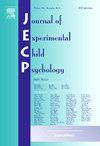Is counting a bad idea? Complex relations among children’s fraction knowledge, eye movements, and performance in visual fraction comparisons
IF 1.8
2区 心理学
Q3 PSYCHOLOGY, DEVELOPMENTAL
引用次数: 0
Abstract
Understanding fraction magnitudes is crucial for mathematical development but is challenging for many children. Visualizations, such as tape diagrams, are thought to leverage children’s early proportional reasoning skills. However, depending on children’s prior knowledge, these visualizations may encourage various strategies. Children with lower fraction knowledge might rely on counting, leading to natural number bias and low performance, whereas those with higher knowledge might rely on more efficient strategies based on magnitude. This study explores the relationship between students’ general fraction knowledge and their ability to visually compare fraction magnitudes represented with tape diagrams. A total of 67 children completed a fraction knowledge test and a set of comparison tasks with discretized and continuous tape diagrams while their eye movements, accuracy, and response times were recorded. Cluster analysis identified three groups. The first group, high-achieving and applying magnitude-based strategies, showed high accuracy and short response times, indicating efficiency. A second high-achieving group frequently used counting strategies, which was unexpected. This group achieved the highest accuracy but the longest response times, indicating less efficiency. The third group, low-achieving and rarely using counting strategies, had the lowest accuracy and short response times. These students tended to compare absolute sizes rather than relative sizes (i.e., showing a size bias). None of the groups exhibited a natural number bias. The study suggests that counting, although inefficient, does not necessarily lead to bias or low performance. Instead, biased reasoning with fraction visualizations can originate from reliance on absolute sizes.
求助全文
约1分钟内获得全文
求助全文
来源期刊

Journal of Experimental Child Psychology
Multiple-
CiteScore
4.50
自引率
7.70%
发文量
190
期刊介绍:
The Journal of Experimental Child Psychology is an excellent source of information concerning all aspects of the development of children. It includes empirical psychological research on cognitive, social/emotional, and physical development. In addition, the journal periodically publishes Special Topic issues.
 求助内容:
求助内容: 应助结果提醒方式:
应助结果提醒方式:


